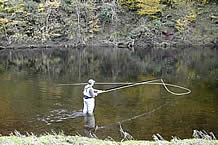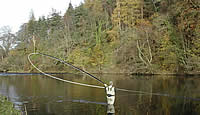In total contrast to the Single Spey, the Double Spey is designed for use in a downstream wind. Lets face it we need a cast for all situations where necessary. The reason it is called a Double Spey cast is simply because it is made up of two basic movements. As with most casts, there are various styles of Double Spey cast, but as long as the mechanics are correct then the style you choose will work. Here are the basic movements.
Movement 1. (The upstream draw)

As we are faced with a downstream wind, we now need to form our D loop on our downstream side, not only is this safer, but it is also more efficient as the wind will hold it there and not blow it towards us.
So, from a fished out downstream position, lift the rod tip to approximately 45 degrees from the water surface then draw the fly line, leader and fly, (under tension) by way of a smooth progressive acceleration, upstream, until you have placed your fly in a position on the water slightly downstream of your body and facing the direction in which you wish to cast. (Your fly does not really want to be any more than a rod length below you at this stage, so the speed of the current should be a consideration when executing this movement). By doing this you will have also placed some fly line upstream of you (see picture on the right) which you will require to create a D loop directly behind your fly on the downstream side when executing movement 2 (see picture below).
Movement 2. (The downstream sweep)

Following on from movement 1. Starting from a low position again, but this time with the rod tip upstream of you, (see picture above) sweep your fly line downstream with a smooth progressive acceleration (once again, under tension) whilst at the same time gradually climbing the rod tip up and around an imaginary spiral staircase. When you are at the top of the staircase and directly behind your fly on the water below you, your D loop should then be formed and ready to deliver (see picture here). The direction to which you deliver the cast (for maximum efficiency) will be dependant on your fly placement at the time your D loop has formed i.e. If your D loop, rod tip, Thumb, Fly line, (on the water) Leader and Fly are all facing the direction to which you wish to cast then it is highly likely that the outcome will be an efficient cast.
Remember as in the Single Spey, this rule applies to both banks, the only difference with this particular cast is as follows: left bank Left hand up and right bank right hand up.
For further information on the Double Spey cast you can view a more in depth article in a PDF document on the following link Click here. This article can also be accessed from the bottom of the Home Page under the heading of Six of the Best Spey Casts.
< Back |
